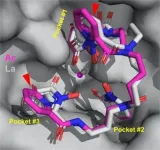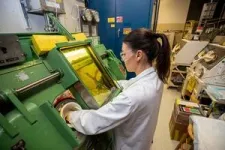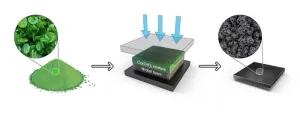(Press-News.org) New research from a Max Planck Florida Institute for Neuroscience researcher could transform how we understand the way opioids affect the brain. Despite significant discussion surrounding the ongoing opioid crisis, current understanding of how opioids function in the brain is quite limited. This is primarily due to challenges in observing and measuring opioid effects in the brain in real-time. However, a recent technological breakthrough, led by Dr. Lin Tian and her research team and collaborators, recently published in Nature Neuroscience, has overcome these limitations and is set to transform how scientists study opioid signaling in the brain.
What do we know about opioid signaling?
Pharmaceutical opioids, such as morphine and oxycodone, and illicit opioid drugs like heroin, affect the brain and body by binding to opioid receptors on the surface of cells in the nervous system. These receptors normally respond to naturally-produced chemicals that are released in your brain, called endogenous opioids, including endorphins, enkephalins, and dynorphins. Released in response to pleasurable activities such as laughter, sex, and exercise and aversive activities like injury and trauma, these chemicals bind opioid receptors and reduce the ability of neurons to receive and transmit signals. These cellular effects ultimately lead to the cognitive and behavioral effects associated with opioids, including positive feelings, pain relief, and addiction.
Challenges in understanding opioid signaling
Numerous questions remain about how these behavioral effects are caused by opioids and whether it is possible to harness specific opioid properties such as pain relief without undesirable effects, such as addiction. The opioid scientific literature is extensive and has confirmed that targeting the opioid system is of clinical interest – not only for pain management but also, more recently, for the treatment of mental health disorders such as anxiety and depression. Development of therapeutics that can target these health challenges while preventing the tragedy of the current opioid epidemic requires further understanding of the diverse effects of opioids in the brain.
The diversity of opioid effects on the brain is driven by more than 20 different opioid chemicals produced in the brain and more than 500 different synthetic opioids. Most of these different opioids interact with all three types of opioid receptors with different strengths. Their varied effects depend on the concentration of opioid, the specific receptors present and the brain circuits involved.
“Efforts are underway to harness various therapeutic properties of opioids by targeting specific receptor actions and brain circuits to develop more effective and safer therapeutics. However, these efforts have been hampered by our inability to measure diverse opioid signaling in real-time in the brain effectively,” said Dr. Tian.
New technology opens door to understanding opioids in brain
Through a massive effort developing and testing over 1,000 variants, Dr. Tian’s team has optimized highly-sensitive biosensors based on the three opioid receptors. These biosensors, originally developed while Tian was at the University of California, Davis, emit fluorescence upon opioid binding to the sensor and turn off when the opioid is no longer there. The biosensors, therefore, serve as a proxy for opioid binding to specific opioid receptors. Introducing these sensors into the brain of an animal provides a way to visualize opioid signaling across the brain in real-time.
“The power of this new technology is that we now have the tools to understand the natural opioid system in the brain, including how to distinguish between different opioid effects. We can track endogenous opioid release in real-time, triggered by both reward and aversion and see the differences in opioid signaling in different brain circuits.”
Dr. Tian’s team has already been sharing these new tools widely to accelerate the impact this new technology will have on the understanding of opioids.
Original Publication Information:
Title: Unlocking opioid neuropeptide dynamics with genetically-encoded biosensors
Authors: Chunyang Dong, Raajaram Gowrishankar, Yihan Jin, Xinyi Jenny He, Achla Gupta, Huikun Wang, Nilüfer Sayar Atasoy, Rodolfo Flores-Garcia, Karan Mahe, Nikki Tjahjono, Ruqiang Liang, Aaron Marley, Grace Or Mizuno, Darren Kirin Lo, Qingtao Sun, Jennifer L. Whistler1, Bo Li, Ivone Gomes, Mark Von Zastrow, Hugo A Tejeda, Deniz Atasoy, Lakshmi A Devi, Michael R. Bruchas, Matthew R. Banghart, Lin Tian
Journal: Nature Neuroscience
Link: https://www.nature.com/articles/s41593-024-01697-1
About the Tian Lab
Dr. Lin Tian started as Scientific Director of the Max Planck Florida Institute in October 2023. Before this, she was the Professor and Vice Chair in the Department of Biochemistry and Molecular Medicine at the University of California Davis School of Medicine, where her work on the development of the biosensors began and continue to remain as an adjunct professor. Dr. Tian’s research focuses on engineering optical sensors for monitoring and controlling neural circuitry in living, behaving animals. These new imaging techniques have greatly impacted the field of neuroscience, facilitating new types of biological experiments performed to address previously intractable questions. Her scientific contributions have earned her international recognition as a leader in neuroengineering, with a focus on generating new molecular tools to understand and repair the brain. Research in the Tian Lab focuses on technological innovation and interdisciplinary collaboration to uncover the connection between brain function and behavior in healthy and diseased states, such as neurological and psychiatric disorders. Dr. Tian’s goal is to find treatments for neuropsychiatric diseases that free patients from debilitating symptoms without the unwanted properties characteristic of existing therapeutics.
About the Max Planck Florida Institute for Neuroscience
The Max Planck Florida Institute for Neuroscience, a not-for-profit research organization, is part of the world-renowned Max Planck Society, Germany’s most successful research organization with more than 80 institutes worldwide. Since its establishment, 31 Nobel laureates have emerged from the ranks of its scientists including six in the last four years alone. As its first U.S. institution, MPFI provides exceptional neuroscientists from around the world with the resources and technology to answer fundamental questions about brain development and function. MPFI researchers employ a curiosity-driven approach to science to develop new technologies that make groundbreaking scientific discoveries possible. For more information, visit mpfi.org.
This research was supported by National Institutes of Health including the NIH BRAIN Initiative (U01NS103522, U01NS120820 and U01NS113295), National Institute of Drug Addiction (R37DA033396, R61DA051489, K99058709) and the National Institute of Mental Health (ZIA-MH002970-04) and the National Institutes of Health grants (DA008863, DA058300 and DK126740). This content is solely the responsibility of the authors and does not necessarily represent the official views of the funders.
END
Visualizing addiction: How new research could change the way we fight the opioid epidemic
2024-07-15
ELSE PRESS RELEASES FROM THIS DATE:
Caught in the actinium
2024-07-15
The element actinium was first discovered at the turn of the 20th century, but even now, nearly 125 years later, researchers still don’t have a good grasp on the metal’s chemistry. That’s because actinium is only available in extremely small amounts and working with the radioactive material requires special facilities. But to improve emerging cancer treatments using actinium, researchers will need to better understand how the element binds with other molecules.
In a new study led by the Department of Energy’s Lawrence Berkeley National Laboratory (Berkeley Lab), ...
Out-of-pocket medical costs are substantial and rising for privately insured men with abnormal prostate cancer screening results who require further diagnostic testing
2024-07-15
Prostate-specific antigen (PSA) screening aims to identify men who may harbor potentially lethal prostate cancer, and those with high PSA results often require more extensive (and expensive) diagnostic testing to establish a diagnosis. New research reveals that the out-of-pocket costs for such additional tests are substantial, common, and rising. The findings are published by Wiley online in CANCER, a peer-reviewed journal of the American Cancer Society.
Abnormal screening tests (i.e., elevated PSA) warrant ...
A new method for sustainable synthesis of acetylene from carbon dioxide
2024-07-15
Since its discovery, in 1836, acetylene has emerged as an essential chemical compound in industry, widely used as a chemical building block and fuel. It has applications in the raw material for resins, such as vinyl chloride, welding gas, and illumination. Recent developments aimed at reducing the dependence on petroleum feedstocks have shown that acetylene is a promising platform molecule for producing various base chemicals. Additionally, polyacetylene, a crucial semiconducting material, is made from acetylene. Currently, acetylene is mainly produced through two methods: ...
Localization of anion exchange membrane water electrolysis is a step forward!
2024-07-15
A research team led by Dr. Sung Mook Choi of the Korea Institute of Materials Science, a government-funded research institute under the Ministry of Science and ICT, has developed a one-step electrode fabrication process for the first time in South Korea. This process produces electrodes, a key component of anion exchange membrane water electrolysis, directly from raw materials to a mass-producible level. The team successfully applied this process to a commercial-scale stack of anion exchange membrane water ...
Atomically controlled MXenes enable cost-effective green hydrogen production
2024-07-15
137 countries around the world have signed a "net-zero" climate change agreement to end fossil fuel use and achieve zero carbon emissions by 2050. Hydrogen is being touted as the next green energy source because it emits only water and oxygen when utilized as an energy source. Hydrogen production methods are divided into gray hydrogen, blue hydrogen, and green hydrogen depending on the energy source and carbon emissions. Among them, green hydrogen production method is the most eco-friendly method that produces hydrogen without carbon emissions by electrolyzing water using green energy.
A research team led by Dr. ...
Survey finds most americans believe pain and urinary leakage is normal for women after having children
2024-07-15
Orlando, Fla - A new national survey by the Orlando Health Advanced Rehabilitation Institute finds most Americans believe it’s normal for women to experience pain, pressure and incontinence after having children. But experts say these are actually signs of pelvic floor issues, and while they are extremely common, affecting about a third of women, they are not normal.
“When we say it's not normal, what we mean is it's not something you should have to live with. It's something ...
Opioid prescribing to reduce overdoses, misuse
2024-07-15
New research aims to help reduce the quantity of unused prescription opioids after emergency department visits and lessen the risk of opioid misuse and overdose. The study is published in CMAJ (Canadian Medical Association Journal) https://www.cmaj.ca/lookup/doi/10.1503/cmaj.231640.
VIEW EMBARGOED ARTICLE
Overprescribing is linked to opioid misuse and overdose, with household supplies of opioids associated with an increased risk of overdose, as many people do not dispose of unused medications safely. In Canada, ...
Health research on South Asian communities must be led by South Asians
2024-07-15
Funding agencies in Canada need to review their policies for evaluating research proposals to ensure that South Asian research is conducted by South Asians, write authors in a commentary in CMAJ (Canadian Medical Association Journal) https://www.cmaj.ca/lookup/doi/10.1503/cmaj.231189
VIEW EMBARGOED ARTICLE
Much of the health research conducted in Canada on South Asian diaspora communities has historically been marked by unequal power relations, rather than meaningfully engaging and benefitting these communities.
As the largest and fastest growing diverse ...
Big boost for new epigenetics paradigm: CoRSIVs, first discovered in humans, now found in cattle
2024-07-15
A study published in Genome Biology opens new possibilities to improve production efficiency in the cattle industry and potentially animal agriculture more broadly. A team of researchers at Baylor College of Medicine, Cornell University and the USDA discovered that, like humans, cattle have CoRSIVs. CoRSIVs are regions of the genome carrying chemical markers on the DNA that provide information that may allow farmers to predict and select desirable cattle characteristics, such as milk production, female fertility and resistance to disease.
“Most people know that each person ...
Cancer is the biggest health concern among the public, poll reveals
2024-07-15
Late detection biggest worry in relation to cancer diagnosis, with 55% of people wanting to see future advances in early cancer detection
Public overwhelmingly support use of AI to tackle cancer
43% of people recognise major impact universities can have on reducing deaths from cancer
Cambridge University partnering with NHS to build revolutionary new Cambridge Cancer Research Hospital
Two-thirds of the public say they are very or somewhat worried about being told they have the disease – higher than ...







